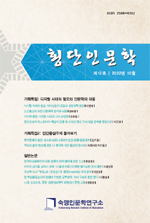키워드
초록
본고에서는 2016년에 발생한 사가미하라 장애인 시설 살상 사건에서 범인이 드러낸 ‘장애’관과 그러한 관점이 연구자들에 경종을 울린 것을 계기로 하여 ‘병자’를 ‘격리’하는 것에 대해 고찰한다. 이때 참조하는 것이 일본제국주의 붕괴 후에도 일본에 남을 수밖에 없던 재일조선인 한센병자의 문학작품이다. 본고에서는 김하일(金夏日), 가야마 스에코 (香山末子)라는두사람의문학적영위를분석대상으로삼아그들이노래/시 짓는행위 를 통해 재구축하는 자기인식과, ‘격리’라는 상황에 대한 이해방법을 더듬어본다. 특히 식민지조선 출신인 한센병요양소의 입소자가 교차성(intersectionality)을 가진 구조적차 별 속에서 자신의 신체와 언어의 관계를 어떻게 구축하고, 그리고 자신의 ‘삶의 장소(居 場所)’를 어떻게 인식했는지를 살펴본다. 본고가 그러한 문학표현을 통해서 도출한 것은 병자 개인의 내적인 정신세계만이 아닌, 병자 스스로가 자신의 표현을 획득해가는 과정 으로, 그것은 자신이 놓인 환경이 어떻게 구축된 것인지를 이해하는 과정과 불가분의 관 계가 있다는 점이다. 거기에서 그려지는 ‘격리’라는 현실을 통해 ‘팬데믹 시대의 혐오’에 대해 생각할 실마리를 얻는 것이 이 논문의 목적이다.
This paper considers the issue of isolating people in sickness by referring to an ideological view over disabilities that is presented by the offender of the Sagamihara care center massacre in 2016 and criticisms from researchers toward such a view. To build my own discussion, I will refer to the literary work by residents of a Hansen’s disease care center, who are also zainichi Koreans(resident Koreans in Japan) who had to remain in the care center even after the liberation from the Japanese Empire after the end of World WarII. The literary activities of two figures, Kim Ha-il and Koyama Sueko, are targets of literary analysis in this paper. I will trace a process of reconstructing their self-identification and recognition of the situation of isolation through creating tanka(Japanese poetry) and poetry. I will especially pay attention to the relationship between their own bodies and languages and how they understand their surrounding discrimination that were structured through the modern history of Japan. This paper discusses not only the internal psychological world of the two poet/poetess but also how their expressions were inevitably tangled with the environment in which they were forced to stay against their will by the government eugenic policies and societal prejudices. A goal of this paper is to get a clue from such an experience of isolation to reflect on hatred in the age of the pandemic. 本稿では、2016年に起きた相模原障害者施設襲撃事件で犯人が露わにした「障害」観 とそうした考え方に対する研究者たちの警鐘を契機として、「病者」を「隔離」すること について考察する。その際に参照するのが日本帝国主義の崩壊後も日本に残らざるを えなかった在日朝鮮人のハンセン病者による文学作品である。金夏日、香山末子という 二人の文学的営為を分析の対象として、彼・彼女らが歌/詩を作るという行為を通して 再構築する自己認識と「隔離」という状況への理解を辿っていく。特に、植民地朝鮮出身 のハンセン病療養所入居者が、交差性(intersectionality)をもった構造的差別のなかで、 自らの身体と言語の関係を構築し、そして自分の「居場所」をどのように認識していっ たかを考えていく。本稿がそうした文学表現から見出したいのは、病者個人の内的な精 神世界だけではなく、病者が自身の表現を手に入れていく過程で、自身が置かれた環境 がどのように構築されたかを理解することと不可分に結びついていることである。そこ で描き出される「隔離」という現実から「パンデミック時代の嫌悪」を考える手がかりを 得ることがこの論文の目的である。
목차
시작하며
1. 장애의 ‘사회 모델’에서 후퇴한 사가미하라 사건
2. 한센병자와 격리정치
3. 김하일의 단카
4. 가야마 스에코의 시
5. ‘격리’의 폭력을 재확인한다는 것
참고문헌
참고문헌 (0)
등록된 참고문헌 정보가 없습니다.
해당 권호 수록 논문 (0)
등록된 수록 논문 정보가 없습니다.
